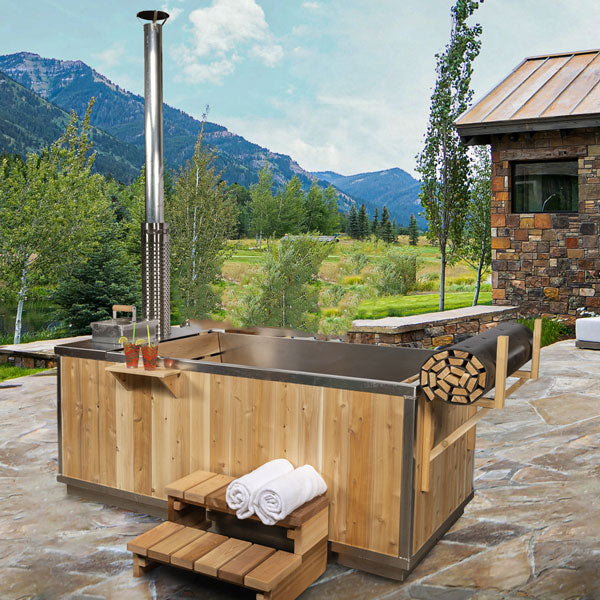
Heating Wood-Fired Hot Tub: A Guide to Efficient and Eco-Friendly Relaxation
Exploring the pleasures of a wood-fired hot tub transports one to a realm of sensory delight, where the traditional method of heating soothes the mind and body. A wood-fired hot tub, distinct in its off-the-grid charm, offers an experience that engages the senses through the warmth of the fire and the gentle rise of water temperature.
Advantages of Wood-Fired Hot Tubs
Wood-fired hot tubs stand apart from electric ones with their unique appeal. Here, the crackle of burning wood and the natural scent engulf the surroundings, offering a tranquil retreat. Brands like the Haven Of Heat collection provide an array of beautiful tubs that fit seamlessly into diverse environments, enhancing outdoor living spaces.
Preparing the Wood and Tub
To initiate the perfect soak, the right wood selection is crucial. Hardwoods such as oak, maple, and birch are preferred for their ability to burn hotter and longer, unlike softwoods like pine, which burn quickly and produce excessive residue. By ensuring the wood is dry and seasoned, efficiency is enhanced, minimizing smoke production. Stacking the fire involves laying a solid base with larger logs, topped with smaller kindling, maintaining airflow to sustain the burn.
For the tub itself, filling with water before lighting the fire is essential. This precaution prevents heat damage to the structure. When setting the fire, kindling serves as the starter with newspaper or firelighters aiding in ignition. Patience is required as larger logs are gradually added.
Managing Soaking Temperatures
Monitoring water temperature is a continual process, with ideal ranges falling between 100°F to 104°F. A thermometer is a valuable tool in maintaining this balance. Stirring the water occasionally ensures even heat distribution, and adding wood incrementally helps in tweaking the soaking temperature. Smaller logs fine-tune this process.
Prominent Models on the Market
Among noteworthy options, the SaunaLife Model S4 combines traditional craftsmanship with modern conveniences, widely appreciated for its efficiency and user-friendliness. Another excellent choice is the Starlight Wood Burning Hot Tub, which pairs robust construction with elegant design, enhancing heat retention to extend warmth effectively.
Enhanced Soaking Experiences
Incorporating aromatics like cedar or eucalyptus can elevate the wood-fired hot tub experience. Maintaining the tub's cleanliness, including regular chimney checks, contributes to a smoother heating process. Safety precautions remain paramount, with a water source always accessible for emergencies, and the fire should never be left unsupervised.
Maintaining the Ideal Soak
Achieving the perfect hot tub experience includes attention to elements like water circulation, which aids in maintaining a consistent soaking temperature. Using an insulated cover when the tub is not in use conserves energy and retains heat. Rigid insulation can also be beneficial in cold weather conditions. Proper care involves regular attention to water quality, checking the pH levels, and using chemical treatments as needed. A functional water filter ensures clean and clear soaking conditions.
Conclusion
Wood-fired hot tubs offer more than just a warm soak; they elevate the bathing experience with an unhurried and intimate connection to nature. The various facets of wood selection, fire management, and temperature regulation come together to create a soothing environment. While enjoying this unique method, users explore not just relaxation, but a lifestyle choice that celebrates simplicity and craftsmanship. Brands such as Goodland and others employing western red cedar further highlight the aesthetic possibilities and durability, making wood-fired hot tubs a timeless choice for wellness and relaxation.
Frequently Asked Questions

How to Create a Homemade Wood-Fired Hot Tub Heater
To construct a wood-fired hot tub heater yourself, you'll need to gather materials like firebricks, a metal barrel, a chimney pipe, and some basic tools. Start by designing a heat chamber to fit the tub. Ensure the fire chamber is well-ventilated and connected to a proper chimney. Safety and efficiency are key in this undertaking.
Ideal Materials for a Wood-Fired Hot Tub Heat Exchanger
For building a heat exchanger for a wood-fired hot tub, materials such as copper or stainless steel are excellent choices. These metals are known for their superior thermal conductivity and resistance to corrosion, making them suitable for prolonged exposure to water and heat.
Time Required to Heat a Wood-Fired Hot Tub
Typically, heating a wood-fired hot tub can take between two to three hours to reach a comfortable temperature. This duration can vary depending on factors like the tub's size, ambient temperature, and wood quality used in the fire.
Operating Expenses Compared to Electric or Gas Heaters
Wood-fired hot tubs often have lower operating costs in comparison to their electric or gas counterparts. Firewood is generally more affordable and accessible. Note: The exact costs will depend on local wood prices and availability.
Water Change Frequency in a Wood-Fired Hot Tub
Changing the water in a wood-fired hot tub every few weeks is advisable, depending on use and water quality. Regular changes help maintain cleanliness and ensure a pleasant bathing experience. Using a water treatment or filter can also prolong the time needed between changes.
Steps for Maintaining a Wood-Fired Hot Tub
Maintaining a wood-fired hot tub involves several steps:
- Regular Cleaning: Clean the tub and heater to remove ash and debris.
- Wood Supply Management: Ensure you have a ready supply of seasoned firewood.
- Water Treatment: Use appropriate chemicals to maintain water quality.
- Inspecting Components: Regularly check the condition of the tub, heater, and any connecting parts for wear or damage.
By following these steps, users can enhance the lifespan and efficiency of their wood-fired hot tub.

Leave a comment